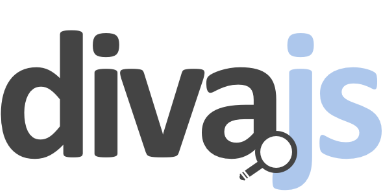Diva.js 
Diva.js (Document Image Viewer with AJAX) is a JavaScript book image viewer designed to present multi-page documents at multiple resolutions.
Version 6.0 contains many new features and improvements:
- Compatibility with IIIF Presentation API version 2.1 and 3.
- Small footprint, zero dependencies. Can be deployed with just a JavaScript and a CSS file.
- Rewritten in ES6 for compatibility with the new JavaScript module system.
- New plugins: Metadata, Image Manipulation
Overview
There are two components to a functioning Diva system:
- A IIIF Manifest that will be displayed.
- The Diva.js plugin. The embedded web application that displays the images in a browser.
Details
Using IIIF
Diva.js is an image viewer compatible with IIIF Presentation API versions 2 and 3. Simply supply the path to a valid IIIF Manifest and Diva will display the document as described by the metadata (see Installing).
Installing
From a CDN (hosted)
If you prefer to use a hosted version of Diva, copy and paste the following into the <head> of any webpage to
include all the files necessary to use Diva.js.
<link rel="stylesheet" href="//cdnjs.cloudflare.com/ajax/libs/diva.js/6.0.2/css/diva.css" />
<script src="//cdnjs.cloudflare.com/ajax/libs/diva.js/6.0.2/js/diva.js"></script>Locally (release package)
Download the latest release of Diva. In the diva.js directory you can
find a pre-compiled version. The build directory contains the files necessary
to use Diva. Simply include build/diva.css and build/diva.js in the <head>
of your webpage, as shown in the HTML source of the example index page.
From npm
You can also run npm install diva.js in order to install Diva as a node package. Then, Diva will be located
under node_modules/diva.js/, and you can access the build directory the same as above.
Basic setup
HTML
After including the necessary files, the most basic Diva viewer is instantiated with one (IIIF) required parameter and several optional settings parameters. Diva must target a parent div, in this case diva-wrapper:
<div id="diva-wrapper"></div>
<script>
let diva = new Diva('diva-wrapper', {
objectData: "http://www.example.com/manifest.json"
// possible settings
});
</script>-
objectData: The URL (absolute or relative) to the document's.jsonfile, or a IIIF Manifest
The diva-wrapper selector points to a div element within which the document viewer will appear.
JavaScript
If you wish to include the Diva viewer component into your own JavaScript app, this can be done easily by just importing Diva beforehand.
import Diva from './path/to/source/diva.js';
let diva = new Diva('diva-wrapper', {
objectData: "http://www.example.com/manifest.json"
// possible settings
});There are a large number of settings that can be enabled/disabled for this Diva instance. See Settings for a comprehensive list.
See Installation for full instructions.
Building from source
If you wish to install from source, first you must install node.js and npm. Then, check out the code from our GitHub repository. Once you've obtained the code, change to the project directory and run npm install to fetch all development dependencies.
The full installation gives you access to the un-minified JavaScript source, the plugins, the documentation, and our unit-tests.
npm run develop // Runs a server at localhost:9001 and automatically builds and reloads upon changes
npm run build:develop // Compiles the Javascript and SASS source and places it in the build/ directory
npm run lint // Lints the Javascript source with JSHint
npm test // Runs the unit tests and outputs a report to the console
npm run build:production // Builds the release packageRun npm run develop and navigate to http://localhost:9001 in your web browser to see a basic Diva instance.
See Installation for more information.
Getting help
Help for Diva.js is available through this repository's wiki, in the form of code documentation, installation instructions and usage tips. You can also submit an issue!
Cross-site Requests
You may receive an error that looks something like this:
XMLHttpRequest cannot load http://example.com/demo/imagefiles.json. No 'Access-Control-Allow-Origin' header is present on the requested resource. Origin 'http://localhost:8000' is therefore not allowed access.
This is a security precaution that all browsers use to prevent cross-site request forgeries. If you receive this message it is because your objectData parameter and the server used to serve the Diva page are not at the same server address.
To fix this you must ensure that the Diva HTML page, and the location pointed to by the objectData page are being served by the same server, or you must create an exception using the Access-Control-Allow-Origin header on your server to explicitly white-list the objectData location.
Let Us Know
We're developing Diva.js as part of our research in Distributed Digital Music Libraries. If you use it in your project, it would be great if you could let us know.
